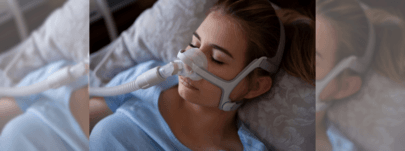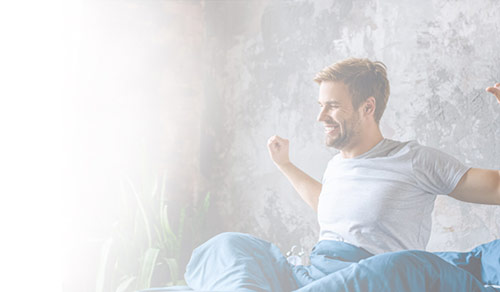
Understanding Your BiPAP Machine Settings
Although CPAP is usually the first positive airway pressure device prescribed to treat obstructive sleep apnea, not everyone can tolerate CPAP. In particular, you might struggle to exhale against the air pressure setting required to keep the airways clear of obstruction.
BiPAP machine settings help to address individual patient needs to boost comfort and compliance.
BiPAP machine settings allow you to set different pressure settings for inhalation and exhalation. This can make BiPAP a more viable option for people who struggle to tolerate the same pressure settings used with CPAP.
BiPAP Pressure Settings
BiPAP delivers different pressure settings for inhalation and exhalation. To accomplish this, the BiPAP machine settings use two prescribed pressure settings:
- IPAP: inspiratory positive airway pressure
- EPAP: expiratory positive airway pressure
EPAP is set to a lower pressure than IPAP. This allows for lower air pressure on exhalation and maintains BiPAP airflow.
Depending on the model, BiPAP machines tend to have a pressure range between 4 and 30 cm H2O. However, the average IPAP setting for inhalation tends to be between 8 and 10 cm H20, while the average EPAP setting for exhalation is typically between 4 cm and 6 cm H2O.
The pressure ranges are determined by a sleep study and programmed into your BiPAP device by your healthcare provider or sleep specialist. They should not be changed without consultation.
Mode
There are various BiPAP machines on the market, but they typically offer up to three user modes in the machine settings to further aid breathing comfort.
- Spontaneous: This is the standard auto bi-level setting, where the BiPAP device senses the breathing patterns and switches between IPAP and EPAP pressure levels according to when the user is inhaling or exhaling.
- Timed: How long each inhalation and expiration phase lasts is programmed into the device to ensure the correct number of breaths per minute. This setting is more suitable when BiPAP is being used as a non-invasive ventilator.
- Spontaneous/Timed (S/T): This dual feature sees the timed setting kick in if breathing rates drop below the required breaths per minute.
A BiPAP machine can often also have a CPAP mode, in which the device delivers one air pressure setting. In this mode, there is no variation in IPAP and EPAP pressure settings. This mode offers the option to use the device as a CPAP to deliver continuous positive airway pressure.
Ramp Time Feature
The ramp time feature setting is another nod to user comfort. It is not easy to adjust to inhaling and exhaling against a prescribed air pressure, and you may find it harder to fall asleep.
This feature allows you to set a lower pressure setting when you first go to bed. The pressure setting will gradually increase until it reaches the prescribed setting.
You set the length of time until the prescribed pressure setting is reached in the BiPAP machine settings. Typically, the time range you can program is between 5 and 45 minutes. You also don’t have to use the feature, in which case you can keep it switched off.
Some modern machines include an auto ramp feature, where breathing patterns are monitored, and the pressure is increased based on how quickly the device determines you are falling asleep. There is also a newer type of device called an Auto Server Ventilator (ASV) that automatically sends a timed breath to the patient to regulate their breathing throughout the night. These devices are used by those who suffer from central sleep apnea. They act like a BIPAP S/T but auto-sense breathing stoppages and provide a timed breath when needed.
Mask Fit Detection
A crucial element of any positive airway pressure treatment plan is having a properly fitting mask. An ill-fitting mask can be the source of air leaks that affect the effectiveness of your sleep apnea treatment.
An ill-fitting mask can be just downright uncomfortable, too. It can move around or sit too tightly against the skin. Red marks, sores, and skin irritation can result from an ill-fitting mask.
BiPAP machine settings help you detect potential issues with your mask. The mask fit detection feature assesses your mask and how well it fits and alerts you to any problems. This helps you make adjustments to the mask to prevent air leaks and improve comfort levels.
The mask fit detection feature is another user-friendly BiPAP tool that helps address the needs of the individual user and encourages compliance with the sleep apnea treatment plan.
Humidity Level
Waking with a dry mouth or nasal congestion was one of the main complaints about using positive airway pressure devices to treat sleep apnea. This resulted from the inhalation and exhalation of dry air delivered by the device.
Modern BiPAP devices have a heated humidifier that adds warmth and moisture to the air. It is another comfort feature that helps boost compliance and improve the quality of sleep. You can control the humidity level of the humidifier to help optimize personal comfort. Typically, the humidity level can be set between a range of 1 and 8, with 1 being the lowest humidity setting and 8 the highest.
Therefore, if you experience dry mouth, irritation, or nasal congestion, you can increase the humidity level setting until this is no longer an issue. Conversely, if you are experiencing moisture in your mask or tubing, you can reduce the humidity level setting until this is resolved.
Bear in mind that it can take a little trial and error to adjust the humidity level setting and arrive at the level that provides the most comfort while using BiPAP. Most modern devices have an auto humidifier setting that allows the user to set the temperature of the air that is delivered.
You should only change BiPAP machine settings in consultation with your healthcare provider. However, these settings add a layer of control that addresses the needs of the individual rather than providing a one-size-fits-all solution to treating sleep apnea through positive airway pressure therapy.




